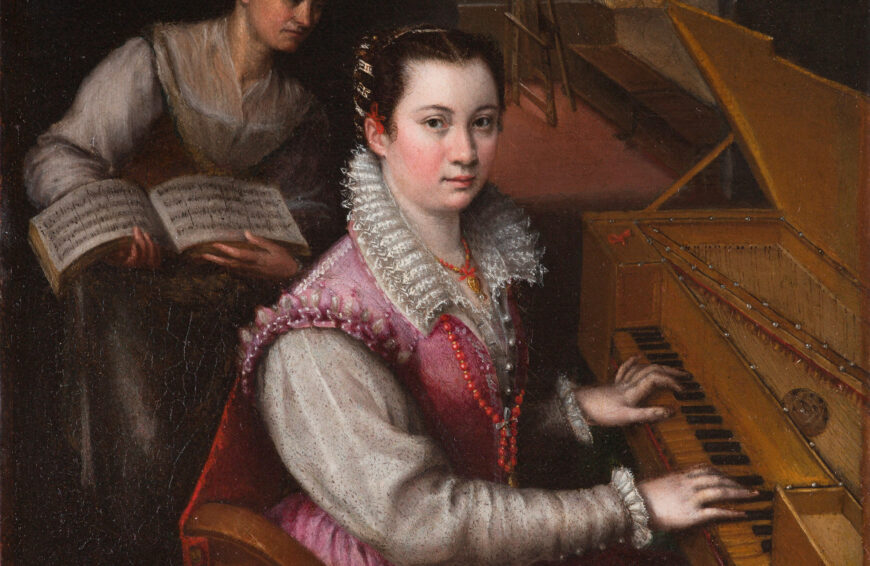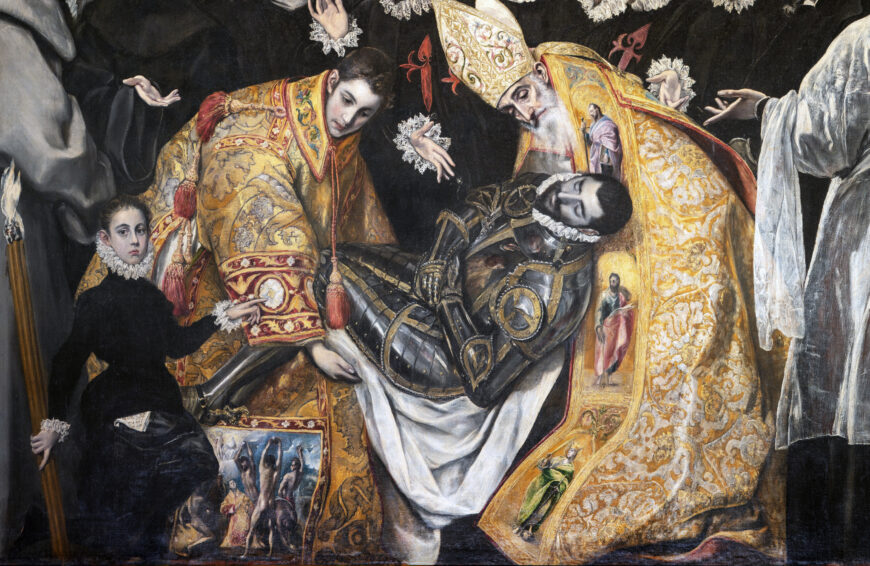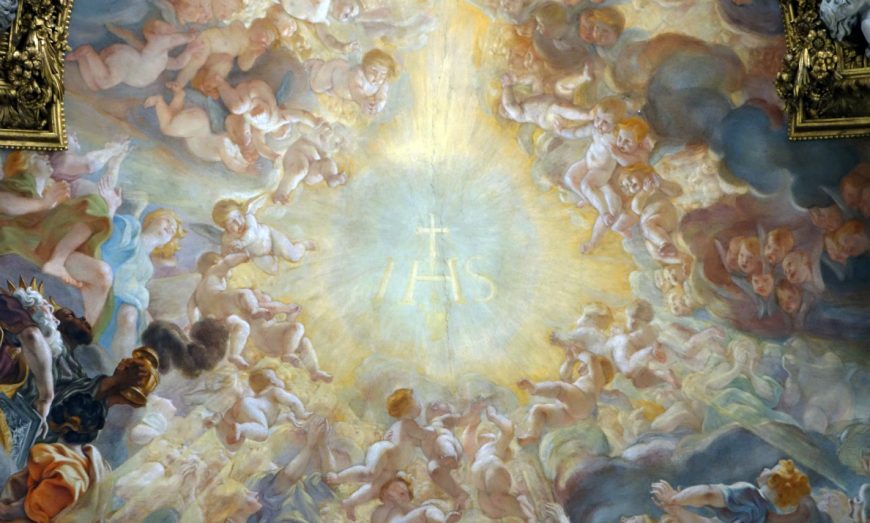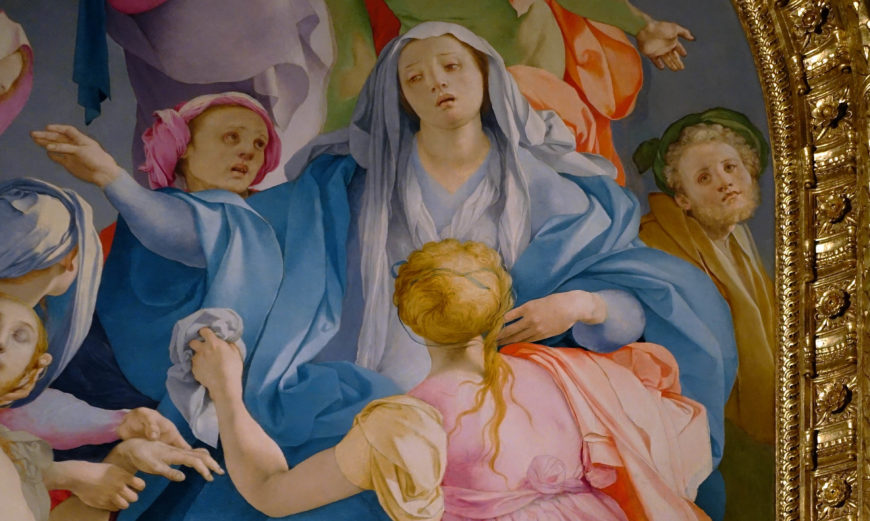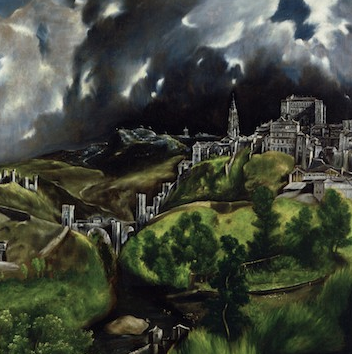
Jacopo Tintoretto, The Removal of the Body of Saint Mark, 1562–66, oil on canvas, 397 x 315 cm (Gallerie dell’Accademia di Venezia; photo: Steven Zucker, CC BY-NC-SA 2.0)
Tintoretto’s florid and dramatic painting style has led many art historians to think of his work as an outlier in the Venetian painting tradition, better known for the quietude of Giovanni Bellini’s altarpieces and harmonious colors of Titian’s narrative canvases. However, Tintoretto was the only major 16th-century artist who was born in Venice and who worked almost exclusively for Venetian patrons commissioning works for Venetian locations. His works for the city’s institutions give us insight into how civic pride and legends were expressed to viewers eager to see their state mythology pictured in their city churches and confraternities.

The city-state of Venice consisted of the city itself, a conglomerate of islands clumped together in a lagoon just off the Adriatic coast of mainland Italy, and an empire consisting of islands in the Adriatic, parts of the Dalmatian coast, and parts of northern Italy near the lagoon. Territorial evolution of the Republic of Venice, 697–1797 (map: Netzach, CC BY-SA 4.0)

Scuola Grande di San Marco e Chiesa Santi Giovanni e Paolo, Venice (photo: Mark Edward Smith, by permission) © Mark Edward Smith
Tintoretto’s The Removal of the Body of Saint Mark is one of three large narrative paintings Tintoretto delivered in the 1560s to the Scuola Grande di San Marco, Venice’s most important confraternity. All three canvases portrayed the miracles of Saint Mark, patron saint of both the confraternity and the state of Venice. The three new works by Tintoretto joined a preexisting painting cycle depicting episodes from the life of Saint Mark.

Jacopo Tintoretto, The Removal of the Body of Saint Mark, 1562–66, oil on canvas, 397 x 315 cm (Gallerie dell’Accademia di Venezia; photo: Steven Zucker, CC BY-NC-SA 2.0)
Saint Mark
Saint Mark, one of Christ’s twelve apostles and one of the four gospel writers, traveled around the Mediterranean after Christ’s ascension spreading Christianity. In Egypt, Mark was made bishop of Alexandria (according to the medieval hagiographer Jacobus de Voragine) and was conducting mass on Easter Sunday in the church he founded at Baucalis when pagans attacked and killed him. [1] Because early Christians feared cremation would prevent a body from resurrecting when Christ returned to earth, the small new community of Christians stole Saint Mark’s body from the funeral pyre to preserve it. Saint Mark’s body stayed in Alexandria until the 9th century C.E. when two Venetian merchants sailed to Egypt, stole the evangelist’s body once more, and transported it to its current resting place in Venice.

Jacopo Tintoretto, The Removal of the Body of Saint Mark, 1562–66, oil on canvas, 397 x 315 cm (Gallerie dell’Accademia di Venezia; photo: Steven Zucker, CC BY-NC-SA 2.0)
The painting
The Removal of the Body of Saint Mark—a large painting at about thirteen feet high—depicts the dramatic seizure of Saint Mark’s body from a pagan funeral pyre shortly after his martyrdom in the 1st century C.E. Tintoretto creates a sense of motion with the use of steep one-point perspective. The piazza seems to narrow at the hazy church closing the paved square. A powerful storm drags black clouds across a sky turned orange as staccato white lead brushstrokes indicate rain and lightning whipping against the piazza, driving figures to seek shelter underneath the loggia of the two-story building on the left.
The central figural group of three men strains to carry the nude, slumped corpse of Saint Mark. His weight sags in their arms. A camel, our first indication of the story’s location (Alexandria), shrugs off its handler to join the saint. The foreground figure on the ground clutching at a piece of pink drapery made more sense before the painting was cut down in the 19th century. Thanks to an early modern etching made by Andrea Zucchi, we know that Saint Mark’s soul flew out of the painting at the left as the bystander clutched a pink mantle, one that appears in Tintoretto’s other paintings of the saint for the Scuola Grande di San Marco.
Body parts of saints or objects touched by saints during their lifetimes, known as relics, were highly desirable to Christians. Because relics were believed to hold the presence and power of a saint’s holiness, pilgrims undertook long journeys to sites that held relics. The more important the saint, the more important the reliquary site.

The current resting place for Saint Mark’s body, Saint Mark’s Basilica, Venice (photo: Venicescapes, CC BY-SA 4.0)
Prior to acquiring Saint Mark’s relics, Venice had a relatively unknown patron saint: Saint Theodore, a minor Byzantine military figure. The procurement of a full-body relic of one of the twelve apostles and one of the four evangelists signaled the political and cultural importance of the growing city and helped shed its subservient status to the Byzantine Empire. There was just one catch: Venice needed to portray that its possession of Saint Mark’s body was morally correct and not the result of an illicit theft. Tintoretto’s The Removal of the Body of Saint Mark was just one of many artworks and texts that sought to establish Saint Mark’s presence in Venice as predestined.

Left: Jacopo Tintoretto, The Removal of the Body of Saint Mark, 1562–66, oil on canvas, 397 x 315 cm (Gallerie dell’Accademia di Venezia; photo: Steven Zucker, CC BY-NC-SA 2.0); right: Canaletto, The Piazza San Marco in Venice, c. 1723–24, oil on canvas, 141.5 x 204.5 cm (Thyssen-Bornemisza National Museum, Madrid)
Referring to multiple stories
Because so many aspects of the painted setting resemble the Piazza San Marco, Venice’s governmental and religious center, Tintoretto’s painting has often been mistaken for the 9th-century theft of Saint Mark’s body, and its transport from Alexandria to Venice. [2] Apart from the camel, the painting gives little impression of Alexandria. Instead, the paved square, columned buildings, and church façade resemble the Piazza San Marco, the square where confraternity members of the Scuola Grande di San Marco often participated in state pageantry. Details resemble parts of the actual city square. The colonnaded loggia atop several stairs resembles the classicizing government office buildings (procuratorie) lining Piazza San Marco. Until the conquest of Venice by Napoleon in 1797, the small church of San Geminiano stood at the end of the square. [3] Moreover, the men carrying Saint Mark’s body progress towards the foreground, where, if we imagine the painted piazza as Piazza San Marco, the Basilica San Marco stood—the church where Venice keeps Saint Mark’s relics.
Creating visual confusion between stories could be a deliberate strategy to draw analogies between two distinct stories. When a viewer initially mistook the 1st-century Alexandrian theft of Saint Mark’s body with the 9th-century Venetian theft of Saint Mark’s body, the later theft became a repetition of the first, right, and moral taking of the body. The visual conflation of the two episodes helped justify Venice’s theft of Saint Mark’s relics from the Christian community in Alexandria.

Left: Jacopo Tintoretto, The Removal of the Body of Saint Mark, 1562–66, oil on canvas, 397 x 315 cm (Gallerie dell’Accademia di Venezia; photo: Steven Zucker, CC BY-NC-SA 2.0); right: Raphael, Entombment, created for Atalanta Baglioni’s chapel, San Francesco al Prato, Perugia, 1507, oil on panel, 184 x 176 cm (Galleria Borghese, Rome)
In addition to merging the two thefts, Tintoretto took advantage of iconography to add meaning and allusions to the composition. [4] Supported by a small group of figures, Saint Mark’s undressed body with a limp arm dangling in the classical gesture of death suggests the common Christian iconography of the Deposition, the moment following the Crucifixion in which Christ’s followers carried his body away from Golgotha. By arranging the figure of Saint Mark in a pose associated with Christ, Tintoretto underscored how devotees of the Venetian patron saint understood him to be Christ-like, further enhancing the cult of Saint Mark.
A Venetian artwork
The Removal of the Body expands its scope beyond a basic depiction of a single episode of Saint Mark’s life. Through a series of visual choices blending aspects of Venice’s Piazza San Marco, Tintoretto drew parallels between different moments in the legend of Saint Mark. These visuals make the argument: Saint Mark’s body was always meant to arrive in Venice, and the theft and transport to Venice was a justified part of holy history. Visual art can make complex arguments succinct and often more palatably than expository texts, burdened with the precision of language. In a Venetian confraternity portraying the patron saint of the state, Tintoretto mixed Saint Mark’s life abroad with his future in Venice, contributing to Venetian mythology centering the lagoon city.



